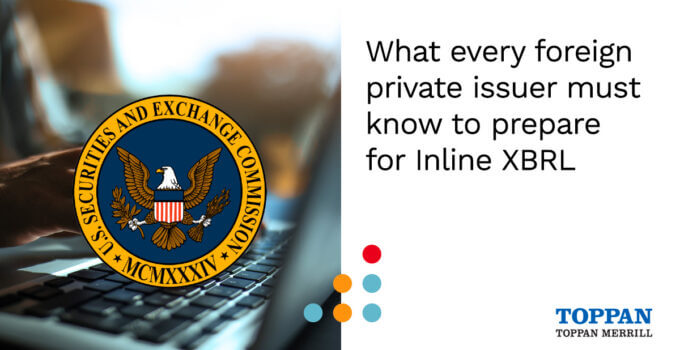Inline XBRL (iXBRL) allows XBRL tags to be embedded directly into an HTML filing, providing a single, transparent format that is readable by machines and humans. By moving to iXBRL on form covers and financial statements in Form 20-F and Form 40-F annual reports, the SEC continues its pursuit of modernizing financial reporting.
Inline XBRL has become the filing standard across the globe. One example is with the European Single Electronic Format (ESEF). As required by the European Securities and Markets Authority (ESMA), beginning Jan. 1, 2021, issuers must submit their AFR in xHTML, and tag the IFRS annual consolidated financial statements in iXBRL.
For foreign private issuers, now is the time to prepare
The final iXBRL rules had a three-year phase-in period beginning in 2019, with all companies, including FPIs, mandated to file in iXBRL format for all periods ending on or after June 15, 2021. Foreign private issuers should partner with a service provider now to successfully prepare for the SEC’s iXBRL requirements and year-end annual report.
Six key factors to know for Inline XBRL
1. Cover page tagging
While preparing the HTML cover, consider how the cover will appear when filed and how the data will be tagged in iXBRL. SEC rules under the FAST Act require “all cover data to be tagged” for every financial periodic report (10-Q, 10-K, 8-K; 20-F and 40-F Annual Reports). Check the SEC’s template for each form type to ensure your filing matches the most current requirements and cover language. For example, the Form 40-F cover contains over 30 data points to be tagged.

The SEC has standardized cover items to ensure consistency in financial reporting across companies and periods. That consistent “structure” allows the data to be tagged so a person or machine can read both the HTML and the XBRL. The 20-F and 40-F cover pages include more information than in the past, including the FAST Act table. Cover tagging should align with the HTML cover, ensuring an issuer is accurately telling investors its financial story.
2. Exhibit index
Under the final iXBRL rule, Exhibit 104 (“Cover Page Interactive Data File”) is used for cover tagging. However, the SEC did not program EX 104 on EDGAR, so it cannot be attached to a submission. Rather, the EX 101 file set used for XBRL financial statements is also used for cover tagging. Issuers are compliant with the EX 104 requirements by using EX 101 instead. This affects the exhibit index for filings with Inline XBRL.
In Forms 20-F or 40-F annual reports, Exhibits 101 and 104 should both be listed, with 104 cross-referenced to 101. For example:
101.INS XBRL Instance Document — the instance document does not appear on the Interactive Data File because its XBRL tags are embedded within the Inline XBRL document
101.SCH XBRL Taxonomy Extension Schema Document
101.CAL XBRL Taxonomy Extension Calculation Linkbase Document
101.DEF XBRL Taxonomy Extension Definition Linkbase Document
101.LAB XBRL Taxonomy Extension Label Linkbase Document
101.PRE XBRL Taxonomy Extension Presentation Linkbase Document
104 Cover Page Interactive Data File — the cover page interactive data file does not appear in the Interactive Data File because its XBRL tags are embedded within the Inline XBRL document
Note that the word Inline is required in the exhibit index for any filing with Inline XBRL.
3. Test filing – review warnings and errors
With iXBRL tagging residing within the HTML coding, the EDGAR system validates most cover data. Since the SEC has programmed EDGAR to check both cover and financial tagging, it is critical to be alert for issues. After submitting a test filing, any inconsistencies will produce a validation warning. Service providers should review the EDGAR test-filing warning message; issuers should resolve any warnings and errors. Even if everything appears to be accurate on the cover, some cover-tagging issues do not appear until the test filing. All warnings must be resolved to ensure your financial story is accurately being reported. An XBRL error (not a warning), will cause the EDGAR system to suspend the filing.
4. Financial statements – XBRL quality matters
Because Inline XBRL tags are immediately visible when a filing is disseminated, issuers should work with their service providers prior to filing to ensure tagging accuracy.
5. Requirements for registration statements
Is the registration statement required to be tagged in iXBRL? Once a company is mandated to submit its Securities Exchange Act of 1934 filings with Inline XBRL, any registration statement that includes full financial statements must have the data tagged for iXBRL.
6. New required auditor tags in annual reports
In December 2021, the SEC adopted the Holding Foreign Companies Accountable Act final rule.
The rule requires disclosure of three specific, auditor-related items in upcoming annual reports on Forms 10-K, 20-F and 40-F (date on/after Dec. 15, 2021). Also, the SEC is requiring that these three values be Inline XBRL tagged:
- Auditor(s)
- Location where the auditor’s report has been issued
- The PCAOB ID Number of the audit firm(s) or branch(es) providing the opinion
In the final rule, the SEC didn’t mandate placement for the three items within the annual report. The EDGAR Filer Manual indicates that the items should be visible and suggests placing them in the auditor report. XBRL US provided guidance regarding placement.
Looking for more information on the SEC’s iXBRL requirements for foreign private issuers? Visit our SEC reporting page to learn more – or connect with one of our experts at [email protected] or by calling 800.688.4400. Our team of iXBRL experts are up to date on the latest SEC rulemaking and prepared to help your company stay in compliance.




